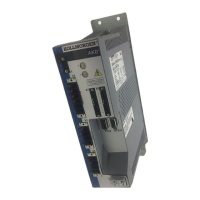6.1 General Description of CAN
This chapter describes the basic services and communication objects of the CANopen communication profile
DS 301, which are used in the AKD.
It is assumed that the basic operating functions of the communication profile
are known, and available as reference documentation.
The transmission method that is used here is defined in ISO 11898 (Controller Area Network CAN for high-speed
communication).
The Layer-1/2 protocol (Physical Layer/Data Link Layer) that is implemented in all CAN modules provides,
amongst other things, the requirements for data.
Data transport or data request is made by means of a data telegram (Data Frame) with up to 8 bytes of user data,
or by a data request telegram (Remote Frame).
Communication objects (COBs) are labeled by an 11-bit Identifier (ID) that also determines the priority of objects.
A Layer-7 protocol (Application Layer) was developed, to decouple the application from the communication. The
service elements that are provided by the Application Layer make it possible to implement an application that is
spread across the network. These service elements are described in the CAN Application Layer (CAL) for Indus-
trial Applications.
The communication profile CANopen and the drive profile are mounted on the CAL.
The basic structure of a communication object is shown in the following diagram:
S
O
M
COB-ID R
T
R
CTRL Data Segment CRC A
C
K
EOM
SOM Start of message
COB-ID Communication Object Identifier (11-bit)
RTR Remote Transmission Request
CTRL Control Field (e.g. Data Length Code)
Data Segment 0 to 8byte (Data-COB)
0byte (Remote-COB)
CRC Cyclic Redundancy Check
ACK Acknowledge slot
EOM End of message
AKD CANopen | 6 CANopen Communication Profile
Kollmorgen™ | November 2012 27

